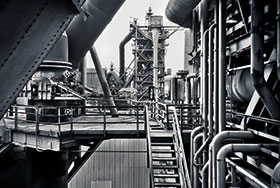

Local manufacturing firms continue to face headwinds from heightened global competition from countries such as China and India, to sluggish demand and macroeconomic conditions, to critical skills shortages and labour issues. However, technology can help to relieve one of the most common pain points, the stubbornly high cost of production. By using the right digital tools, manufacturers can sustainably reduce their production costs, breathing new life into their margins and ensuring profitable operations.
Three areas in which this can be achieved are:
1. Raw material inventory and production planning
By using digital tags like RFID, plant operators can gain greater insight into materials, equipment, parts and other assets. Combine this with other datasets and it is possible to build up a rich picture of materials as they flow through a factory to eventually become finished products. By knowing exactly where everything is, it becomes easier to plan production, as data is automatically piped into a manufacturing execution system or production lifecycle management system. This means faster logistics and greater throughput of products, as well as increased levels of uptime and productivity – ultimately driving down input costs.
Rapid advances in 3D printing mean that certain parts and materials that are required urgently can be created on-site and at short notice, even further enhancing the management of materials.
One of the leaders in this space is General Electric. The company is reinventing itself with a variety of strategically connected technologies. These include lean manufacturing, additive manufacturing (also known as 3D printing) and advanced software analytics to enhance productivity. At Grove City, GE has used these technologies to reduce unplanned downtime by 10 to 20%, improve cycle time and reduce costs.
2. Predictive maintenance and predictive analytics
With sensors gathering key data on each machine – from humidity, heat, wear and tear, usage times, oil levels, and various other data points – it is possible to start predicting when a machine is likely to fail or require servicing. This principle, known as predictive maintenance, helps to curtail the cost of managing industrial equipment and reduces unexpected downtime as services, repairs and refurbishments can all be scheduled to avoid interrupting production lines.
With findings suggesting that downtime costs the average factory between 5 and 20 percent of its productive capacity, predictive maintenance can be one of the most crucial weapons in the fight against ballooning production costs.
It is possible to extend the principle of predictive maintenance to encompass predictive analytics across the entire factory operations. With predictive alerts coming in from all corners of the factory, it becomes possible to orchestrate the operations more dynamically, changing the daily plan according to fresh data that comes in from along the production line.
3. Proof of concept prototypes
In traditional manufacturing, creating a new prototype for a particular product was a lengthy and extremely expensive endeavour, particularly when the concept turned out to be the wrong one and never progressed into full-scale production. But with cutting edge digital simulations, 3D representations and holograms, it becomes possible to play around with various new prototype designs, testing them with users and getting a tangible feel. By creating sophisticated prototypes in these new ways, the dramatic upfront costs of producing a single unit on the production line are greatly reduced. In this way, rapid prototyping and proof of concept can cut out another layer of cost.
As traditional manufacturers evolve towards smarter and more digital production lines, it is not always easy to know where to invest first to get the greatest ‘bang for your buck’. But by focusing on these three areas, and then building from these foundations and gradually connecting other technologies, manufacturers can address the most pressing pain point, input costs, and set themselves well on the way to reducing the cost of production.
For more information contact Dereshin Pillay, T-Systems South Africa, +27 (0)84 671 5284, [email protected], www.t-systems.com/za/en

© Technews Publishing (Pty) Ltd | All Rights Reserved